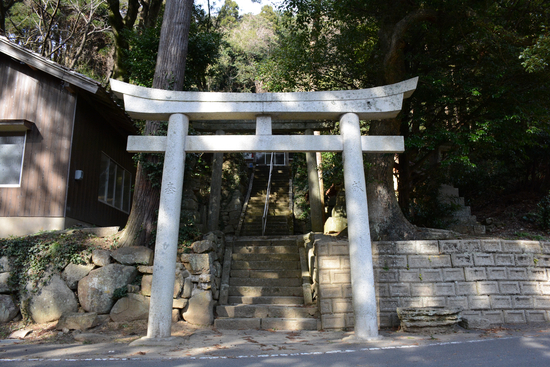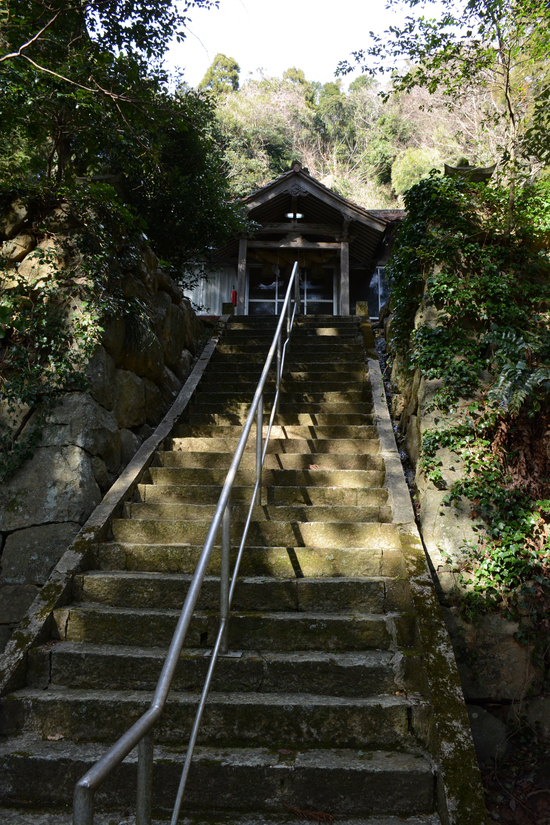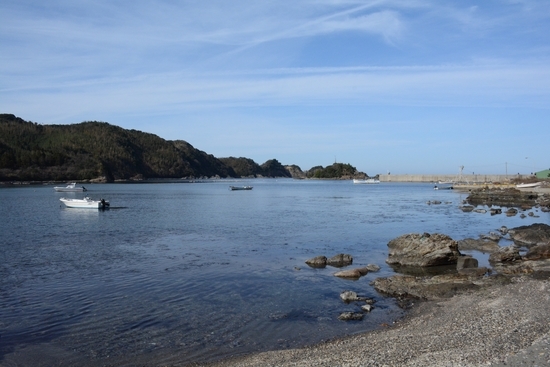Sasago-ura
| Bay Name | Sasago-ura |
|---|---|
| Shrine Name | Tamai Daimyoujin(Former) Tamae jinja(Current) |
| Deity | Tamayorihime no mikoto |
| Location |
Matsue-shi Mihonoseki cho Katae 1618 |
Sasago ura Tamai Daimyoujin
Heihaku wo Sasago no ura no Kamu-yashiro
Mamoreya yotsu no umi mo yutaka ni

The ’Sasago’ of the poem was a village in the Katae Bay area. While the modern day Tamae shrine is certainly located in Sasago, it does have a connection to Tamae village located just over the mountain pass.
In the Izumo Fudoki, this bay is described as, "Tamae Beach, Goishi ( black/white stones used in the ancient strategic board game, ’Go’) produced here. Rough grindstones can be found along the eastern side of the beach. Peasant dwellings present." In modern times, although nobody resides along the beach anymore, there are homes along with the shrine further inland.
The ’Tamae Beach’ mentioned in the Fudoki is actually located in the aforementioned Tamae village rather than in Sasago port and black stones can indeed be picked up at ebb tide.
Regarding the former name of the shrine, Tamai daimyoujin is most likely the same ’Tamae myoujn’ that is listed in the ’Unyoshi’ and the Tamae-oyashiro of the Fudoki.
While the written characters have changed over time, there is no doubt that the name of the previously mentioned Tamae village originates from the shrine of the same name. This ’tamae’ ( tama written with the characters of ’ball/jewel’ and the e meaning tied/connected but also carrying the meaning of inlet/bay when written with the character e used in Katae ) with its abundance of precious Go stones could also be read as the ’jewels’ from the inlet/bay, watched over by the shrine deity, Tamayorihime.
This word ’tama’ curiously connecting the area, its produce and the shrine make Sasago a mysterious place indeed.

The ’Ohimachi’ New Year event used to enjoy the participation of every household in Tamae village.
Up to ten years ago, the Toshitokujin deity was paraded through the town in the o-mikoshi (portable shrine). As participants able to transport the shrine dwindled, the task then went to a small truck, but this too, is no longer in operation. Back in the day when the local youth used to carry the o-mikoshi, it actually used to end up in the sea around Tamae, suggesting the connection to the Tamae-ura shrine deity, Tamayori -hime, daughter of the sea god. The o-mikoshi is still stored nearby the shrine, the stonemasonry dragon decorations now worn but a reminder of the festival of the past.
The Goishi stones mentioned in the Fudoki can be collected along the shore here, only 200m from Tamae shrine. There are certainly plenty of black stones readily available with the white processed from seashells.
Back in the day, the village masons would make their way over the mountain at the rear of Tamae shrine to get to the coast to collect stones used for knife sharpening. With this road no longer open, there is only one way to get back from the sea now.
The stone wall surrounding the steps leading to the shrine is known for its unusual composition. It is said that it may have been built by either a craftsman specializing in castle structures, or possibly an early settler from China or Korea.
In the mountains opposite Tamae jinja, there are several smaller shrines, including one for the deity that protects against disasters, Koujinsan. This is another example of the extent of the coverage of Fudoki shrines in the area.

| Bay Name | Sasago-ura |
|---|---|
| Shrine Name | Tamai Daimyoujin(Former) Tamae jinja(Current) |
| Deity | Tamayorihime no mikoto |
| Location |
Matsue-shi Mihonoseki cho Katae 1618 |
Sasago ura Tamai Daimyoujin
Heihaku wo Sasago no ura no Kamu-yashiro
Mamoreya yotsu no umi mo yutaka ni
The ’Sasago’ of the poem was a village in the Katae Bay area. While the modern day Tamae shrine is certainly located in Sasago, it does have a connection to Tamae village located just over the mountain pass.
In the Izumo Fudoki, this bay is described as, "Tamae Beach, Goishi ( black/white stones used in the ancient strategic board game, ’Go’) produced here. Rough grindstones can be found along the eastern side of the beach. Peasant dwellings present." In modern times, although nobody resides along the beach anymore, there are homes along with the shrine further inland.
The ’Tamae Beach’ mentioned in the Fudoki is actually located in the aforementioned Tamae village rather than in Sasago port and black stones can indeed be picked up at ebb tide.
Regarding the former name of the shrine, Tamai daimyoujin is most likely the same ’Tamae myoujn’ that is listed in the ’Unyoshi’ and the Tamae-oyashiro of the Fudoki.
While the written characters have changed over time, there is no doubt that the name of the previously mentioned Tamae village originates from the shrine of the same name. This ’tamae’ ( tama written with the characters of ’ball/jewel’ and the e meaning tied/connected but also carrying the meaning of inlet/bay when written with the character e used in Katae ) with its abundance of precious Go stones could also be read as the ’jewels’ from the inlet/bay, watched over by the shrine deity, Tamayorihime.
This word ’tama’ curiously connecting the area, its produce and the shrine make Sasago a mysterious place indeed.
The ’Ohimachi’ New Year event used to enjoy the participation of every household in Tamae village.
Up to ten years ago, the Toshitokujin deity was paraded through the town in the o-mikoshi (portable shrine). As participants able to transport the shrine dwindled, the task then went to a small truck, but this too, is no longer in operation. Back in the day when the local youth used to carry the o-mikoshi, it actually used to end up in the sea around Tamae, suggesting the connection to the Tamae-ura shrine deity, Tamayori -hime, daughter of the sea god. The o-mikoshi is still stored nearby the shrine, the stonemasonry dragon decorations now worn but a reminder of the festival of the past.
The Goishi stones mentioned in the Fudoki can be collected along the shore here, only 200m from Tamae shrine. There are certainly plenty of black stones readily available with the white processed from seashells.
Back in the day, the village masons would make their way over the mountain at the rear of Tamae shrine to get to the coast to collect stones used for knife sharpening. With this road no longer open, there is only one way to get back from the sea now.
The stone wall surrounding the steps leading to the shrine is known for its unusual composition. It is said that it may have been built by either a craftsman specializing in castle structures, or possibly an early settler from China or Korea.
In the mountains opposite Tamae jinja, there are several smaller shrines, including one for the deity that protects against disasters, Koujinsan. This is another example of the extent of the coverage of Fudoki shrines in the area.






